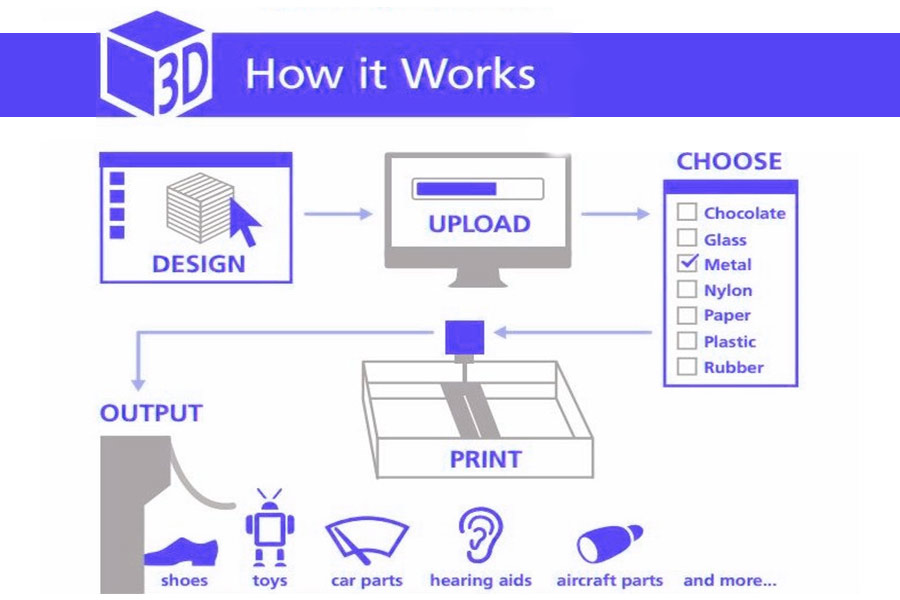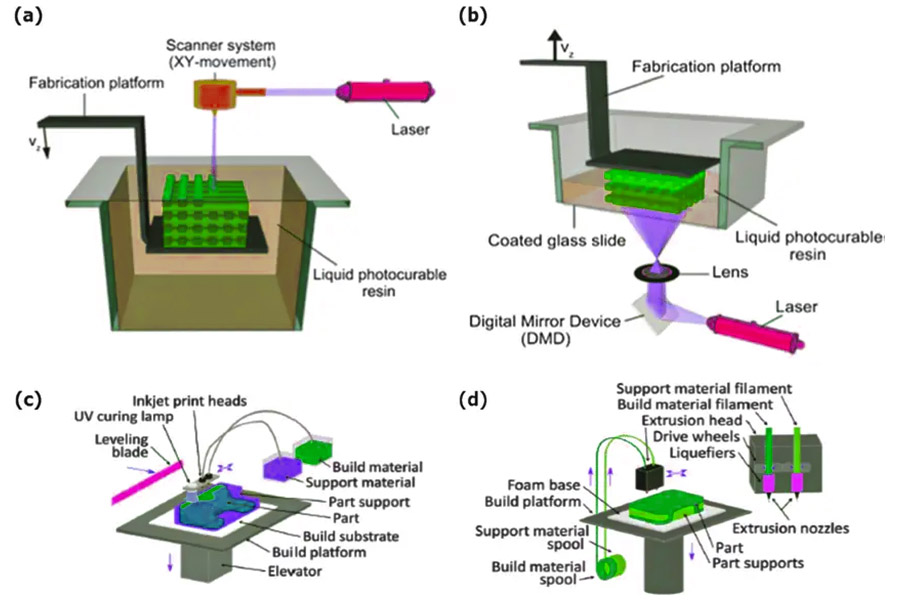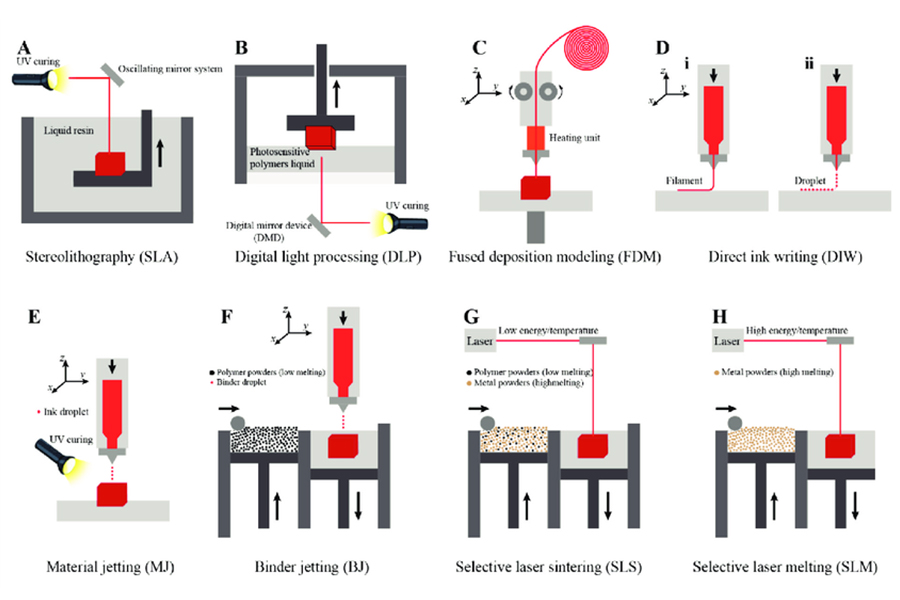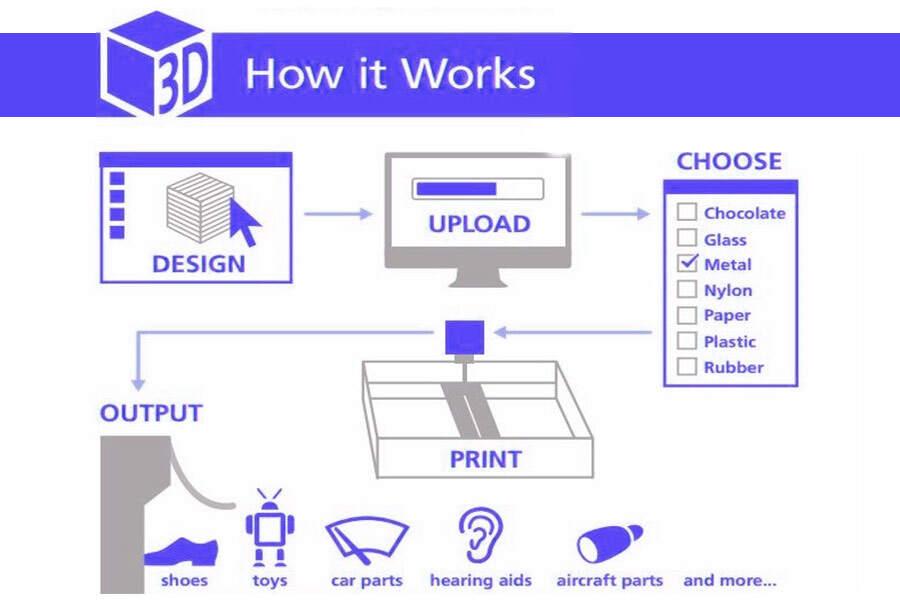Today, with the rapid development of science and technology, a revolutionary manufacturing technology is quietly changing our world - this is3dprinting The unique charm and infinite possibilities of this technology have attracted the attention of countless people. It has broken the peak of traditional manufacturing and opened up new paths in the fields of innovation, rapid prototyping and personalized customization. So,how does3D printingwork?This article will take you to explore the mysteries of this cutting-edge technology and unveil its mysterious veil.
What is 3D Printing?
3D printing, the full name of three-dimensional printing or additive manufacturing technology, is a technology that builds three-dimensional entities by accumulating materials layer by layer. Different from traditional subtractive manufacturing (such as cutting) or equal material manufacturing (such as casting,forging),3dprintingstarts directly from the digital model and uses precision equipment under computer control to stack materials into the required form. Shape and size. This process requires no molds or tools, greatly increasing design freedom and manufacturing flexibility.
How does 3D Printing work?
1.Digital modeling
First,a digital3d models printing needs to be created using computer-aided design (CAD) software or other 3D modeling software. These software enable users to design complex geometric shapes and create structures. After completion, users can export the 3d printing modelsto 3D file formats such as STL and OBJto facilitate subsequent processing in 3D printing software.
2.Data processing
Import the3d printing modelfileinto the 3D printing software, and the software will generate a series of slice information based on the model data. This slice information describes the shape and position of each layer in detail, providing guidance for the subsequent printing process. According to specific printing needs, users need to adjust printing parameters, such as layer height, printing speed, material temperature, etc., to ensure that the printed items meet the design requirements.
3.Printing process
Place the selected printing material (such as plastic, metal, ceramic, etc.) into the 3D printer. These materials are usually in powder, liquid or filament form and can be pre- or cured as desired. The 3D printer will heat,ink jet printing or extrude the material layer by layer based on the slice information, and display them together accurately. The process is similar to manual machining in traditional manufacturing, but 3D printing enables more complex structures and shapes. During the printing process, the 3D printer will control the temperature of the material according to default parameters to ensure printing quality and stability.
4.Post-processing
For some complex structures that require support, 3D printers will add additional brackets during the printing process. After printing, these brackets need to be removed. Since there may be some imperfections during the printing process, such as rough surfaces, gaps between layers, etc., the printed objects need to be trimmed and polished to improve their appearance and performance.


What are the Different Types of 3D Printing Technologies?
3D printing technology is rich and diverse, covering the printing needs of a variety of materials from plastics to metals, from biomaterials to food. The following are several typical types of 3D printing technologies:
1.FDM
1.1Overview of the technology
FDM(Fused Deposition Modeling), also known as FFF (Fused Filament Fabrication), is the best-known technology, and a part of the Material Extrusion process. It uses thermoplastic materials, typically in the form of spools of filaments. The heated nozzle of the extruder melts the material which is then deposited onto a substrate. There are several advantages of FDM. The printing process is easy to learn, medium-fast and usually doesn’t require a lot of space. The majority of printers are desktop-sized which makes them ideal for the office. But on the other hand, FDMs are also used as big industrial machines, to support manufacturing processes. In such cases, pellet form of the build material can be used rather than a filament.
1.2Materials
FDM allows the use of a wide variety of thermoplastic materials, such as ABS, PLA, PETG, and TPU as the most common, and more complex materials like composites with carbon fiber, glass fiber, or even graphene for conductivity. These materials offer various mechanical, thermal, and chemical properties, allowing you to choose the most suitable material according to the specific needs of the project.
1.3Advantages of FDM
-
Non-toxic, but some filaments like ABS produce toxic fumes. Usually it is environmentally safe process.
- Wide range of colorful printing materials, not so expensive, and with high utilisation.
- Low or moderate costs of equipment.
- Low or moderate post-processing costs (support removal and surface finishing).
- Best for medium-sized elements.
- The porosity of the components is virtually zero.
- High structural stability, chemical, water and temperature resistance properties of materials.
- Rather big build volume comparing to other desktop technologies: 600 x 600 x 500 mm.
1.4 Disadvantages of FDM
- Limited design options. Can’t produce thin walls, acute angles, sharp edges in vertical plane.
- Printed models are the weakest in vertical build direction because of the anisotropy in material properties due to additive layer method.
- Supports are needed.
- Not very accurate, with the tolerance between 0.10 to 0.25 mm.
- Tensile strength is approximately two-thirds of the same material that has been injection-moulded.
- Difficult to control build chamber temperature, which is crucial for best results.
- Problem of “stair-stepping” in vertical build plane.
1.5 Applications
- Low-cost rapid prototyping
- Basic proof-of-concept models
2.SLA
2.1 Overview of the technology
A technique known as photopolymerization is used by stereolithography (SLA), a3D printing method, to produce three-dimensional objects. It was among the earliest methods for additive manufacturing to be created, and it’s still in use today. SLA is commonly used in applications that require high-resolution prototypes, detailed models, jewelry, dental applications, and other industries where accuracy and fine details are crucial.
2.2 Materials
SLA uses photosensitive liquid resins asprinting material. These resins are available in a variety of properties, such as stiffness, flexibility, heat resistance, and chemical resistance. Some resins are also designed to mimic specific materials, like ABS, polypropylene (PP), and rubber.
2.3 Advantages of SLA
- Excellent surface finish with layer thickness between 0.05 – 0.15 mm.
- Finished parts can be painted.
- Moderately fast.
- Economical for low production (1-20) parts.
2.4 Disadvantages of SLA
- Expensive materials.
- Post-processing is not only required but also multithreaded, messy process. After the print is done, the resin needs to be washed in an ultrasonic bath or by dunking a part in IPA (isopropyl alcohol), then the supports must be removed and after that, the printouts needed to be cured with UV light.
- The resin alone is toxic, but mixed with IPA is even more dangerous. The liquid should be secured and sent for disposal to a specialized company.
- Waste material is not recyclable and is hard to manage
- Supports are needed
- Printouts are the weakest in vertical build direction due to anisotropy in material properties because of the additive layer method.
- Laser needs to be calibrated periodically
- The layer-thickness may vary in different resins
- Photopolymers are toxic, as well as the fumes that are escaping during the process.
2.5 Applications
- Functional prototyping
- Patterns, molds, and tooling
- Dental applications
- Jewelry prototyping and casting
- Modelmaking


3.SLS
3.1 Overview of the technology
SLS is a 3D printing technology based on the selective fusion of thermoplastic powders using a high-power laser. The machine spreads a thin layer of powder on the build platform, and the laser traces the layer pattern on the powder surface. As the powder fuses, the build platform descends, and the process is repeated for the next layer. SLS is particularly suitable for the production of functional parts and durable prototypes.
3.2Materials
SLS uses thermoplastic powders, such as nylon (PA), polyamide (PA), polystyrene (PS), and thermoplastic polyurethane (TPU). These materials offer strong mechanical and thermal properties, making them ideal for functional and high-performance applications.
3.3 Advantages of SLS
- No support structures needed.
- Movable parts with complicated inner geometry.
- Smooth surfaces – it is hard to notice the layer.
- Sustainable printouts.
- Powder is reusable after printing.
- Low to moderate material costs, while using the full working area.
- Desktop SLS 3D printers are inexpensive compared to industrial machines.
- Skilled labour is not required (only desktop SLS 3D printers).
3.4 Disadvantages of SLS
- Industrial machines are expensive.
- Long lead time.
- Cleaning of the machine must be done precisely when changing material to avoid contamination.
- Long printing time (for larger objects).
- For a powder management during post-processing a vacuum cleaner and compressed air is recommended as it can get dusty.
3.5 Applications
- Functional prototyping
- Short-run, bridge, or custom manufacturing
Comparison of the advantages and disadvantages of 3D printing technology
| Parameter | FDM | SLA | SLS |
| Advantages |
Low-cost consumer machines and materials Fast and easy for simple, small parts |
Great value High accuracy Smooth surface finish Fast printing speeds Range of functional applications |
Strong functional parts Design freedom No need for support structures |
| Disadvantages | Low accuracy Low details Limited design compatibility |
Sensitive to long exposure to UV light | Rough surface finish Limited material options |
What are the advantages of 3D printing?
Compared to CNC machining, which uses subtractive manufacturing, additive manufacturing adds material in layers until the product is complete. There are manyadvantages of 3d printingfor both large businesses and individuals.
1.Manufacturing complex items does not increase costs
As far as traditional manufacturing is concerned, the more complex the shape of the object, the higher the manufacturing cost. With3d printing service, the cost of manufacturing complex-shaped items does not increase, and creating a gorgeous complex-shaped item takes no more time, skill, or cost than printing a simple square. Making complex items without increasing costs will upend traditional pricing models and change the way we calculate manufacturing costs.
2. Product diversification without increasing costs
3D printing can print a variety of shapes, making items of different shapes like a craftsman every time. Traditional manufacturing equipment has fewer features and is limited in the variety of shapes it can produce. Instead of training machinists or buying new equipment, 3D printing requires different digital design blueprints and a new batch of raw materials.
3.Zero-skill manufacturingb
Traditional craftsmen require several years of apprenticeship to acquire the skills they need. Mass production and computer-controlled manufacturing machines have reduced skill requirements, but traditional manufacturing machines still require skilled professionals for machine adjustments and calibration. 3D printing takes various instructions from a design file and requires less operating skills than an injection molding machine to make the same complex object. Unskilled manufacturing opens up new business models and provides new ways for people to produce in remote environments or extreme situations.
4.No assembly required
3D printing has the characteristic of one-piece molding, which is very helpful in reducing labor and transportation costs. Traditional mass production is based on industrial chains and assembly lines. In modern factories, machines produce the same parts and are then assembled by workers. The more components a product has, the longer the supply chain and product line stretch, and the more time and cost it takes to assemble and ship. 3D printing integrates molding functions and eliminates the need for reassembly, thereby shortening the supply chain and saving labor and transportation costs.
5. Zero-time delivery
3D printing enablesprinting serviceon demand. Just-in-time production reduces a company’s physical inventory, and companies can use3D printingto manufacture customized parts based on customer orders to meet customer needs, so new business models will be possible. Zero-hour production can minimize the cost of long-distance shipping if the goods people need are produced nearby on demand.
6.Unlimited design space
Traditional manufacturing techniques and craftsmen create products into limited shapes, and the ability to create shapes is limited by the tools used. For example, a traditional wooden lathe can only make round items, a rolling mill can only process parts assembled with a milling cutter, and a forming machine can only make formed shapes. 3D printing can break through these limitations, opening up vast design spaces and even creating shapes that may currently only exist in nature.
7. Unlimited material combinations
Today's manufacturing machines have difficulty combining different raw materials into one product because traditional manufacturing machines cannot easily combine multiple raw materials during the cutting or molding process. With the development of multi-material3D printing technology, we have the ability to fuse different raw materials together. Previously unmixable raw materials will be blended to form new materials that come in a variety of shades and offer unique properties or functions.
8.No space, portable manufacturing
In terms of unit production space, the manufacturing capacity of 3D printing is stronger than that of traditional manufacturing machines. For example, an injection molding machine can only make items much smaller than itself, in contrast to a3D printerthat can make items as large as its printing table. After the 3D printer is adjusted, the printing equipment can move freely, and the printer can make items larger than itself. The high production capacity per unit of space makes 3D printers suitable for home or office use because of the small physical space they require.
9.Accurate physical replication
Digital music files can be copied endlessly without any degradation in audio quality. In the future, 3D printing will extend digital precision to the physical world. Scanning technology and 3D printing technology will work together to increase the resolution of morphological transformations between the physical and digital worlds, allowing us to scan, edit and copy physical objects to create exact copies or optimize originals.

When Was 3D Printing Invented?
The origin and development of3D printing technologyhas gone through many stages, and its exact "invention" time may vary with different definitions and milestones. Some people believe that 3D printing technology was born in 1986, which is based on the fact that the technology began to mature and be used in actual production during this period. However, there are also opinions that the origin of 3D printing can be traced back to an earlier time, such as 1976, the year when the inkjet printer was born, because the gradual adjustment and advancement ofinkjet printing technologyprovided important technologies for later 3D printing technology. Base.
In the 1980s, Hideo Kodama of Nagoya Industrial Research Institute and Chuck Hull of 3D Systems Company and others made important inventions and contributions to 3D printing technology. They achieved the printing of three-dimensional objects through different technical paths, such as light curing technology. The emergence of these technologies marks that 3D printing technology has officially entered the modern development stage.
Over time, 3D printing technology continues to develop and improve, gradually forming a variety of different technology types and application fields. Today, 3D printing technology has been widely used in industrial manufacturing, medical care, aerospace, architecture, art and other fields, becoming an important force in promoting social progress and development.
In summary, although the specific invention time of 3D printing technology is controversial, it is generally believed that it originated around the 1980s and has been rapidly developed and widely used in the following decades.
What is the History of 3D Printing?
Synonymous with innovation and creativity, 3D printing is not a recent phenomenon. Its origins are much older than you might think.
1940s to 1970s: Imaginative Beginnings
In the 1940s, 3D printing technology was not born in a laboratory but appeared in science fiction novels. Murray Leinster's 1945 short story "Things Pass By" envisions a device that closely resembles a modern 3D printer. Leinster writes that one maker used "magnetoelectronic plastic" to create objects from scanned drawings, a process that mirrors modern computer-automated manufacturing processes.
Likewise, in 1950, Raymond F. Jones introduced the idea of using a "molecular spray" to create objects in his short story "Tools of the Trade," published in Astonishing Science Fiction magazine.
In the 1970s, Johannes F Gottwald patented a liquid metal recorder, an important step towards 3D printing. U.S. Patent 3,596,285A, granted in 1971, describes a continuous inkjet technology using metal powder that enables the shaping and remelting of metal products. This innovation was a forerunner of today's additive technology, which creates three-dimensional objects by depositing layers of material.
The 1980s: A decade of innovation in 3D printing
The 1980s were a dynamic period in the history of 3D printing, as the technology moved from theoretical concepts to tangible breakthrough developments. Significant advances in additive manufacturing technology have led to the filing of key patents, laying the foundation for the 3D printing revolution.
1990s to 2010s:Mature technology and widely used
The 2010s: 3D printing technology has been more widely used and developed. It not only plays an important role in manufacturing, but also shows great potential in many fields such as medical care, architecture, and art.
recent developments
In recent years, with the continuous progress in fields such as materials science, computer science and precision machinery, 3D printing technology has also continued to innovate and develop. New printing materials, printing processes and printing equipment are constantly emerging, making 3D printing technology more widely used, and printing accuracy and efficiency have also been significantly improved. The development of 3D printing technology is a long-term and complex process. It has gone through many stages from early concept exploration to technology germination, preliminary development, key technology and commercialization, technology maturity and widespread application. Today, 3D printing technology has become an important manufacturing technology and plays an important role in various fields.
How is 3D Printing Used in Various Industries?
As a cutting-edge manufacturing technology, 3D printing technology has been widely used in many industries. The following are the specific uses of 3D printing in various industries:
1.Construction industry
Architectural model production:During the architectural design stage, 3D printing technology is used to produce accurate architectural models to help designers and investors better understand and demonstrate design plans.
Building construction:During the construction phase, 3D printing technology can be directly used to build full-scale buildings, which not only saves construction materials, but also significantly shortens the construction period and reduces construction costs. In addition, customers can customize their home and house style according to their personal preferences.
2.Automobile manufacturing
Parts manufacturing:3D printing technology can quickly manufacture various automotive parts, such as engine covers, exhaust pipes and brake discs, etc., improving production efficiency and reducing costs.
Prototype design:In the design stage of new automotive products or parts, 3D printing can quickly produce prototypes and help designers verify the feasibility and market demand of the design solution.
3.Aerospace
Complex parts manufacturing:3D printing technology can manufacture complex parts in aerospace equipment. These parts usually have complex shapes and internal structures that are difficult to process with traditional manufacturing processes.
Parts repair:For damaged parts in aerospace equipment, 3D printing technology can achieve rapid repair, allowing the entire equipment to be quickly restored to use.
4.Medical industry
Surgical model preview:Carry out three-dimensional modeling based on the patient's CT data, and then use a3D printer to print out a medical modelto help doctors intuitively see the three-dimensional structure of the surgical site before surgery and reduce surgical risks.
Rehabilitation equipment manufacturing:3D printing technology can manufacture various rehabilitation equipment, such as orthopedic insoles, bionic hands, hearing aids, etc., to achieve precise customization.
Bio-3D printing:With the upgrade of materials, biocompatible 3D printing materials can now realize the printing of blood vessels, organs and other biological tissues, bringing revolutionary changes to clinical medicine.
5.Education industry
Teaching tool:3D printing technology is used as a valuable and sustainable educational tool to help students transform ideas into tangible objects and cultivate their creativity and hands-on abilities.
Teaching models:In courses such as mathematics and chemistry, 3D printing technology can produce various teaching models to help students better understand abstract concepts.
6.Entertainment industry
Movie special effects production: 3D printing technology plays an important role in movie special effects production. It can produce highly customized special effects props and scene models to improve the shock and appeal of movie images.
Game development: In game development, 3D printing technology can be used to produce physical models of game characters, props, etc., to help developers better verify the feasibility of game design.
The application fields of 3D printing technology are very wide, covering the construction industry, automobile manufacturing, aerospace, medical industry, education industry, entertainment industry, etc. With the continuous advancement of technology and the continuous expansion of application fields, I believe that more and moreprinting shopswill appear in the future. At the same time, 3D printing technology will also appear to bring more surprises and convenience to mankind.

Longsheng: Your partner in 3D printing services
- Multi Material Machining:We have the ability to handle multiple materials, and we can provide professional solutions no matter what material of parts you need to process.
- Competitive Pricing:We provide competitive prices and cost-effective solutions to ensure that customers gain the greatest advantage in cost control.
- Customized Services:Provide customized solutions based on customer design requirements and specifications to ensure that parts meet their unique needs.
- Rapid Delivery:We have efficient production processes and flexible production plans, which enable us to timely deliver customer orders and meet urgent project needs.
FAQs
1.How does 3D printing work in simple terms?
3D printing, a type of rapid prototyping technology, works simply by cutting a digital model file into a series of thin slices, then printing these slices layer by layer, and superimposing them layer by layer to finally form a complete physical object.
2.How do 3D printers work step by step?
3D printing is a production technology that converts digital models into physical objects. Its working principle is relatively intuitive and complex.
First, a digital 3D model needs to be created using computer-aided design (CAD) software or other 3D modeling software. After creation, users can export the 3D model to 3D file formats such as STL and OBJ. Then, import the 3D model file into the 3D printing software, and the software will generate a series of thin slice information based on the model data. Place the selected printing material into the 3D printer. Finally, the printed model is post-processed.
3.Is 3D printing hard to learn?
Although 3D printing technology may have a certain learning curve for beginners, as long as learners have a positive attitude, patience and perseverance, and make full use of available learning resources, they will be able to gradually master this technology and apply it in various fields. Therefore, it can be said that 3D printing technology is not particularly difficult to learn, but it does require a certain amount of effort and practice.
Summary
With the continuous advancement of technology and the continuous innovation of materials, 3D printing technology will have wider application prospects in the future. For example, in terms of material science, we will develop more high-performance, low-cost printing materials; in terms of accuracy and speed, we will continue to improve printing accuracy and printing speed; in terms of application fields, we will further expand to more industries and fields to achieve More innovations and breakthroughs.
Disclaimer
The content on this page is for reference only.LSdoes not make any express or implied representation or warranty as to the accuracy, completeness or validity of the information. No performance parameters, geometric tolerances, specific design features, material quality and type or workmanship should be inferred as to what a third party supplier or manufacturer will deliver through the Longsheng Network. It is the responsibility of the buyerseeking a quote for partsto determine the specific requirements for those parts.Pleasecontact usfor moreinformation.
LS Team
This article was written by multiple LS contributors. LS is a leading resource in the manufacturing sector, withCNC machining,sheet metal fabrication,3D printing,injection molding,metal stamping, and more.





